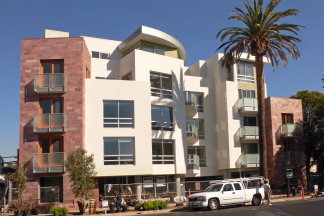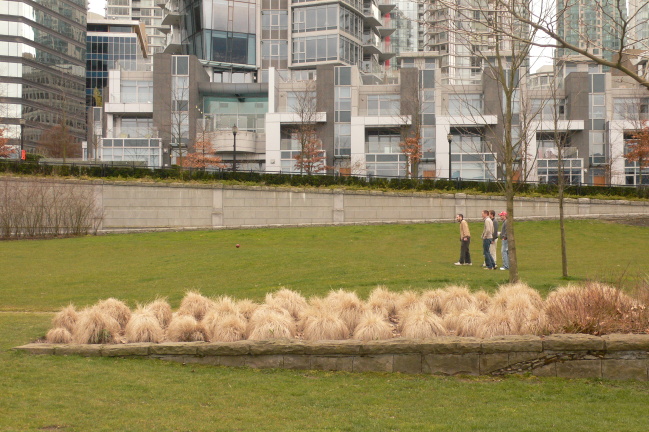I wrote last week that the best city-building I have seen in recent years does not fall into the three "urbanisms" described by University of Michigan professor of architecture Douglas Kelbaugh: New Urbanism, Everyday Urbanism, and Post Urbanism (a/k/a Spectacle Urbanism).
So what is this good urbanism I'm talking about? And where is it?
I'll begin where I live, Santa Monica, California. I call Santa Monica a "post-sprawl" city. Its grid of streets were laid out in the late 19th century by founders who wanted it to become the great port of Los Angeles, but it grew to its present population in the middle decades of the 20th century as part of an early edition of sprawl. Then it had to reinvent itself starting in the 1980s after its blue-collar industries left town and competition from shopping malls (including one that the city subsidized with redevelopment money) devastated its once vibrant downtown retail economy.
As New Urbanist founder Andrés Duany might approve, I have been observing Santa Monica for 25 years, during which the City of Santa Monica applied itself to revitalizing its downtown. It did this first by remaking -- in the '80s -- the major downtown shopping street, a then dead pedestrian mall now known as the phenomenally successful and often imitated Third Street Promenade, and then by enabling -- starting in the '90s -- the building of many five-story apartments (with retail on the ground floor), so that now the downtown has a large and growing residential population.

A five-story apartment under construction in downtown Santa Monica
I'll get to the details of what I have observed in Santa Monica in a moment, but I didn't start to think of what had happened there as a general phenomenon until this past year, when, fortuitously, I was able to visit both Barcelona and Vancouver. Both cities have become laboratories for urbanism in the past two decades.
Barcelona has perhaps always been such. UCLA architecture professor Dana Cuff once told me (she denies that the thought is original with her) that "Barcelona is the only city in the world that became better each century." Barcelona started with an ancient Roman grid, that morphed into a medieval city, and which was expanded in accordance with a well-planned 19th century grid.
Meanwhile Barcelona became an industrial city -- but as in Santa Monica (and many other places) those industries declined in recent, post-industrial decades. Barcelona began rebuilding again in anticipation of the 1992 Olympics, and concentrated its efforts on turning a formerly industrial waterfront into new residential neighborhoods and reclaimed beaches. Last year I had the pleasure of living for a week in an apartment in one of these new neighborhoods.
Vancouver is the North American city that has most energetically tried to reverse sprawl, by building high-rise apartment towers in the central city. But instead of locating these towers away from the street (as with the "tower in a park" model of Modernist Urbanism), Vancouver has required that the towers rise above either townhouses with entrances on the street or street-oriented retail.

Townhouses and towers on a street overlooking a park in Vancouver
Santa Monica (where no new building is taller than six stories), Barcelona (an ancient city, where development, frequently in the form of modern towers, is concentrated in a few areas outside "sacred" historical districts) and Vancouver (a young city where little is sacred) are three quite different places, but I saw these commonalities when it came to city-building:
We're talking about cities; what's gone on in all three places has nothing to do with building small towns or a more urban version of the suburbs. The streets are typically laid out tightly on a grid (either preexisting or newly planned) and all three cities require new buildings to have direct relationships to the street. No virgin lands were harmed to make these places. (I don't mean to imply that retrofitting the suburbs would be a bad thing, or that building new towns can never be justified. But they are not part of this urbanism.)
The developments in all three cities are based on cities being able to maximize and capture the economic value of city real estate. They all represent intensification of uses. The developments have expensive features: most notably, they could not exist in the forms they take if they couldn't justify putting parking underground. The economics of all three places are ultimately based on the fact that post-industrial economies can put more jobs on fewer square feet than can industrial economies, and all three cities -- as opposed to other devastated industrial cities -- have been able to capture that value (which in most late 20th century places escaped to suburban office parks) and convert freed-up extra land to high-value residences. This has taken purposeful governmental action which itself has to be seen as part of this urbanism.

Entrance to underground parking, next to a grocery store, in an apartment building in a new neighborhood of Barcelona
The new developments are environmentally friendly, but in a "casual" manner. Environmental efficiency results from the urban form, not from specific green technologies.
The architecture of the new developments is generally contemporary, but design is always at the service of urbanism -- the buildings may have "spectacular" qualities, but they don't ignore the context.
Okay, that's my description of this "fourth urbanism." I'll need a part 3 to locate it among the other urbanisms -- and maybe name it.
Frank Gruber writes a weekly column on local politics, which often involve land use issues, for the Santa Monica Lookout News, a news website. His first book, Urban Worrier: Making Politics Personal, has just been published by City Image Press.